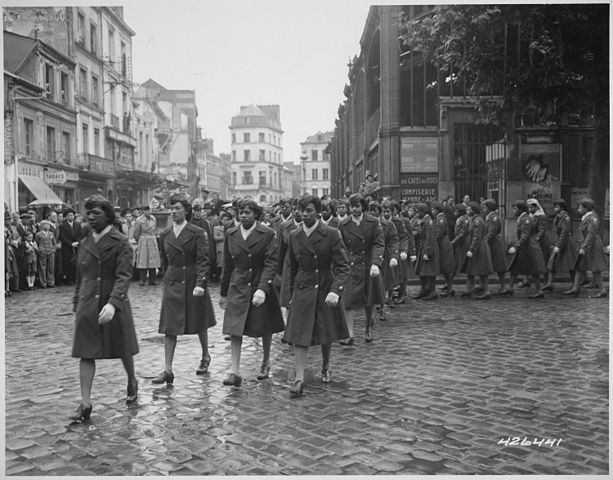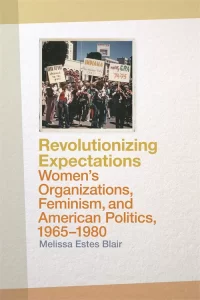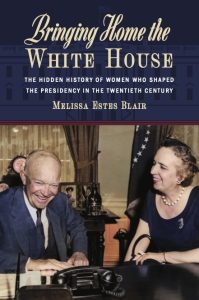From the History in the Margins Archives: The 6888th Delivers the Mail
I know you're tired of hearing it--and believe me, I'm tired of saying it--but I am deep deep deep in book mode. My manuscript is due May 1 (I'll let you do the math) and I have a lot of work yet to do. So for the next few weeks, you can expect a couple of guest posts, a review of a book that I’m really excited about sharing, and more posts from the archives. Up first, this post from 2019 that I think is a nice way to keep the Women's History Month excitement going for a few more days.
In 1945, the U.S. military was seriously behind in delivering the mail to Americans stationed in the European theater. There was a two-year backlog of letters and packages addressed to some seven million soldiers and aid workers. The thankless job of sorting through a warehouse full of undelivered mail was assigned to the 855 African-American women of the 6888th Central Postal Directory Battalion, also known as the “Six Triple Eight,” under the command of Major Charity Adams Early.
Part of the Women’s Army Corps (WAC), the women of the 6888th took the motto “No mail, low morale.” They arrived in Birmingham, England in February 1945, and set to work in unheated and poorly lit warehouses that were stuffed to the ceiling with undelivered packages and letters. (Including undelivered goodies that made the local rodent population very happy.) For three months, they worked three eight hour shifts each day, seven days a week, sending out 65,000 letters each shift.
The sheer volume of undelivered mail was a challenge. But it wasn’t the only challenge. Some of the mail was, shall we say, optimistically addressed: ”Junior. US Army” Even properly addressed mail was difficult to deliver. There were, for instance, 7,500 Robert Smiths stationed in the European theater and frontline soldiers were constantly on the move. In order to make their job easier, they created a system of information cards with serial numbers, one for each soldier—similar to a library card catalog back in the days when catalogs used actual cards.
The 6888th was the only all African-American female unit sent overseas during World War II. Despite the fact that they were making a valuable contribution to the war effort, the battalion suffered the same racial discrimination in the Army as they did in civilian life. They slept in segregated barracks and ate in segregated mess halls. As Major Early recalled, “ We didn’t mix it up. We were segregated in two ways, because we were black and because we were women.” Although white WACS and African-American soldiers were welcomed to a local club for American enlisted personnel run by the American Red Cross, the women of the Six Triple Eight were not allowed to use its facilities. When the Red Cross offered them alternative segregated facilities, Major Early and her women boycotted them and ran their own. Some members of the battalion felt they were treated better by the local people than by their fellow American soldiers.
Once the backlog in Birmingham was cleared, Six Triple Eight was transferred first to Rouen, and later to Paris, to deal with more stashes of undelivered mail.
In February, 1946, with the war over, they returned to the United States and the unit was disbanded. But for twelve months, neither snow, nor sleet, nor broken windows, nor badly addressed envelopes kept them from moving the mail on its appointed rounds.
Women’s History Month comes to an end, again
Back in November, I wondered whether I should run this interview series again this year. As I may have mentioned a time or ten, I’m trudging toward the first big deadline on this book. And while it may not be obvious, putting this series together takes time and energy. I changed my mind several times before I came to the conclusion that doing this project each year is important to me. (Not to mention fun.) I hope it is important to some of you, too. (Not to mention fun.)
Over the last few months I’ve had a chance to interact with some of my history-writing heroes, and find some new ones. I’ve added books to my TBR list and followed new people on Twitter.* I’ve promoted people who are doing wonderful work in our shared project of putting women back into history. And I’ve enjoyed being part of the online celebration of Women’s History Month. (And I’ve tried to answer some really hard questions—this year people posed some doozies!) I hope you've enjoyed it as much as I have.
As always, I feel a little deflated as the month comes to an end—it’s a little like the first week of January after the holiday season is over. And yet, much as I love the sense of celebration, I wish we didn’t need Women’s History Month, or Black History Month, or any of the other history months and heritage months that now mark our calendars. I wish history as we learn it would include people who were not as a center as a matter of course. That we didn’t have to put up big flashing signs that say “WE WERE THERE” once a year to remember. I don’t think that’s coming any time soon. In fact, I fear that Women’s History Month and its sister celebrations are more important than they ever were.
Dang it.
*And yes, I realize Twitter could crash and burn at any moment. But I haven’t found any social media format that suits me quite so well.
***
Over the next few weeks, you can expect a couple of guest posts, a review of a book that I’m really excited about sharing, and more posts from the archives. May 1 is coming really soon.
Talking About Women’s History: Three Questions and an Answer with Melissa Estes Blair
Melissa Estes Blair is an associate professor and department chair of history at Auburn University in Auburn, AL. She received her Ph.D from the University of Virginia, and her B.A. from the University of Kentucky. Her research focuses on women and politics in the twentieth-century United States. Her first book, Revolutionizing Expectations: Women’s Organizations, Feminism, and American Politics 1965-1980 examined the role of mainstream women’s organizations such as the YWCA and League of Women Voters in the feminist movement of the 1970s. Her forthcoming second book, Bringing Home the White House: The Hidden History of Women Who Shaped the Presidency in the Twentieth Century, is a group biography of the directors of the Women’s Division of the Democratic and Republican National Committees in the middle decades of the 20th century. It will be released September 1, 2023 by University of Georgia Press. An early version of part of that work appeared in the 2020 edited collection Suffrage at 100 published by Johns Hopkins University Press.
Take it away, Melissa!
We’re all familiar with the challenges of finding sources for writing about women from the distant past. What are the challenges of writing about women from the mid-twentieth century?
A lot of scholars of the 20th century talk about drowning in paper, and that’s true for women’s history, even at the local level. Whether I was looking at records of YWCA and League of Women Voters chapters for my first book or DNC and RNC records for my current project, there was just so much stuff. And when you are traveling to archives and don’t have a ton of time, you have to triage pretty quickly to make your best educated guesses to ensure that you get through the best material.
The other big obstacle, especially when you are working on local or unknown women, is that even with all that paper it can be hard to figure out who’s who. If the meeting minutes and the mailing list of the LWV chapter, for example, list women by last name only (“In attendance were Mesdames Smith, Jones, Roberts…”) and the mailing list is “Mrs. William Smith,” but then the meeting minutes say “Dorothy suggested that…”, it can be quite hard to match all those names up. That, in turn, makes it hard to follow women into different aspects of their lives like paid employment or other organizations, or to find them for oral history. I did my dissertation research in the 2000s and wrote about the 1960s and 1970s. I’m sure many of the women I wrote about were still alive. But it was actually really hard to find them, because of the ways in which women’s names have historically been recorded. That’s one big reason there isn’t very much oral history in my first book, in spite of my chronological proximity to the topic.
What aspects of women's history surprise your students most? What outrages them?
Almost everything surprises my students, which feeds into what outrages them. They are always appalled by how little they know, especially when it becomes clear that there are ample sources to teach about women throughout American history. Often these discussions go hand in hand. The last time I taught my women’s history class, for example, the students were particularly angry that none of them had heard about the women’s bread riots against the Confederacy during the Civil War. Their frustration with their lack of knowledge enabled us to have a really great discussion about the uses & misuses of history, how the history of white southerners’ frustrations with the Confederacy during the war were suppressed during the Lost Cause era and how that still shapes the education that my (majority Southern) students had received. Their outrage fuels amazing discussions because they are so eager to learn.
When did you first become interested in women's history? What sparked that interest?
I have been interested in history pretty much my whole life, thanks to my mother. She is a native Virginian and a history lover, so when we would go to Virginia to visit her parents, we would often do a little bit of historical sight-seeing, whether it was a trip to Colonial Williamsburg or just an afternoon on the grounds at Maymont, a Gilded Age mansion in Richmond. (Side note: Maymont is now one of the best house museums I’ve ever seen, but when I was a kid the house wasn’t open, just the grounds).
It's hard for me to pin down when women’s history became my focus. I am exactly the right age for the original American Girl dolls, and I devoured those books, which of course narrated historical events from a girl’s perspective. I took a lot of feminist literature classes in college (I was a history & English double major), and that really grew my interest in gender studies broadly. But history has always been my passion, so I combined that interest in women’s experiences that I got from Dr. Ellen Rosenman and other professors at the University of Kentucky English department with my love of history when I got to graduate school.
A question for you: You seem to be a scholar of pretty much everything. How do you do it? How do you manage to keep through lines in such big projects?
There is a reason historians tend to sink their roots into a specific time and space. It is both terrifying and thrilling to drop the safety net of an academic field and explore scholarly foreign territory. And yet, as with any kind of foreign travel, the unknown slowly becomes familiar, freeing you up to push your boundaries one step further.
Since I chose not to follow the academic path long before I finished my doctorate, I have always been free to follow my curiosity where it lead me. And sometimes it seems like I’m curious about everything. That can lead me to really deep dives into specific topics, that are very similar to the type of research that an academic historian does. It also allows me to go wide—moving across fields to look at the ways different ideas or events are connected. Then once I have that web of linked ideas, I can go deep again in what biographer Eric Washington calls a “galaxy of rabbit holes.” Over time, one set of linked ideas connects with another, creating a very personal field of scholarship.
For example, like your students, I had not heard about the women’s bread riots against the Confederacy, so I paused in the middle of working on this post to go down the bread-riot rabbit hole. The bread riots throughout the south were fascinating in themselves, but they linked in my mind to other bread riots I’ve written about: in eighteenth -century France, in England in 1819 and in Russia in 1917—not to mention the related potato riots in Germany during World War I and Weimar Germany and the constant fear of bread riots in classical Rome, leading to the concept of “bread and circuses.” There are some obvious things that link them all together—economic instability for one. But I suspect that if I started going down those rabbit holes I would find something else that was interesting. Will I do it? Not for the next five weeks for sure. Maybe not ever. At a minimum I will probably play with the ideas in a newsletter down the road.
***
Wanted to know more abut Melissa Estes Blair and her work?
Check out her website: https://www.melissablairhistorian.com/
Follow her on Instagram: @MelissaBlairHistorian
***
Come back tomorrow for one last Women's History Month post, in which I hope to wind things up in a meaningful way. No promises.



